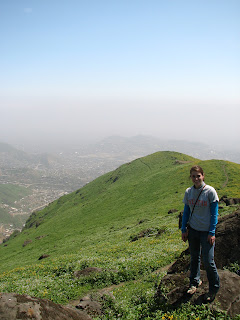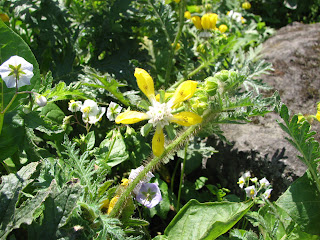From the top of the lomas you can hear a constant hum like a swarm of mosquitoes during summer or like feedback from a static-prone microphone. It is always in the background. At times the noise seems deafening, overbearing and even annoying because you can't escape it. Other times, it fades into the background as your mind focuses on the burrowing owl perched on the rock or the white begonias rising out of the crevices. As I hike miles around these biological islands my initial response is either to ignore or to become annoyed by the honking, loud music, and tire squeals that breaks the natural hum of chattering birds and buzzing bees. Similarly, my natural reaction when I look down over the thousands of casitas enshrouded in a dirty brown haze of contamination and smog is to feel unsettled and even sometimes angry. This "city" and center of hustle and bustle seems so absurdly different from the lomas' nearly invisible trail which takes its pilgrims through fields of wildflowers and up verdant slopes.
While I think some of these reactions are justified, there is a danger here if we create a dichotomy of place and space - that is to believe that to be in the "wilderness" an purely idyllic existence and to be in the "city" is rather uncouth. Interestingly enough, I am sure there are many people that would reverse those descriptions quite readily. However, I think a Biblical perspective forces us to look as the New Jerusalem as a place when man and the rest of creation live in a restored and harmonious existence. The perceived tension and conflict between these two "worlds" is eliminated because our relationships are perfected through Jesus' reconciliatory work on the cross. All of the created order is free to worship their Creator together unhindered by sin and brokenness. In this we see the end of the story which gives us hope to faithfully pursue his Kingdom in the present. And, I think there are lessons to be learned here for both the city-dweller and those of us who are more prone to prefer "no-man's land" because we cannot escape each other :) In fact, I think Jesus knew what he was talking about when he said being a disciple meant BOTH loving our neighbor and keeping and serving his creation.
We need to serve God by keeping his earth. The lomas for example, are not just full of animals, plants, and birds but are home to the Peruvian Desert Fox, the Tabaco tree and the Mountain Parakeet. Each species has a name with its own unique preferences for habitat and food. Together they make up a complex web of life which was created to have its own natural ebb and flow. While humans are a part of this creation, they are also set apart for the purpose of serving and keeping the creation which God had declared good and valuable. There is a responsibility involved here that unfortunately we haven't always fulfilled. Although "the high mountains belong to the wild goats" as the psalmist says in Psalm 104, we also have the opportunity to simply enjoy the world Jesus has made by truly understanding and appreciating its diversity. And, trust me, the more you learn to appreciate creation, the more you will want to protect it - not just because it is full of marvels but also because it is an act of worship and obedience to its Creator. You might also begin to realize how inextricably linked your existence is to the natural world. Next time you sit down to eat your dinner or drive your car to the store, think about where all of this "stuff" came from. It all had to come from somewhere (and I don't mean the shelf) and it is all going somewhere whether to the landfill, the atmosphere, or, as is common here, the street. Ultimately, protecting creation forces us to confront own role in over-consumption, environmental destruction, and waste which harms people and the whole created order.
We need to serve God by loving his people. This brings me back to the beginning of this post. If you listen carefully to the constant drone of the city, the sounds become a little more distinguishable. There is the honking of the convis as they wildly weave their way through the crowded streets. There is the swooning of the Peruvian men when an unfortunate gringa tries to make her way though the the market. There is the chorus of barking dogs who let you know that you are not welcome in their territory. There are the cries of women who have been beat by their abusive and machismo husbands. But, there are also the voices of the faithful singing praises to their God, the laughter of a little child playing peek-a-boo with a new friend, and the sizzling of cheese-filled taquenos on the kitchen stove. I have heard all of these sounds and am more keenly of the beauty and brokenness of the City of Lima. Attached to these sounds are faces, names, stories and context. The city provides an opportunity for community and for people to be in relationship. It is a place where both the best and worst of man is somehow boldly exposed.
But just as we need Jesus to help us restore a right relationship with creation, we also need his help to heal our relationships with each other. We are called to confront systems of injustice, poverty, and neglect because they are not part of the kingdom of God. As we slowly begin to pour out compassion for those who are in greatest need, we will realize our own faults, our own contribution to the warped economic and social systems which fuel these problems and that loving people and taking care of Creation are systematically and intricately connected. And, since more than 60% of the world's population now lives in cities, it seems like we will increasingly have to figure out how to do live out this dual mandate in an urban context. The loma ecosystems and the surrounding communities epitomizes this challenge for me.
The video is a panorama view from the top of the lomas of Villa Maria.
If you listen, you can hear both birds chirping on the hills and cars down in the valley.






























